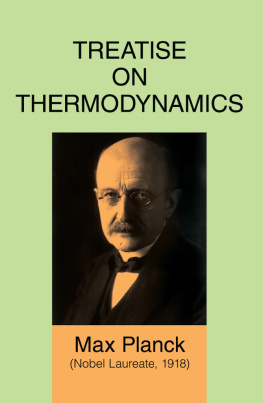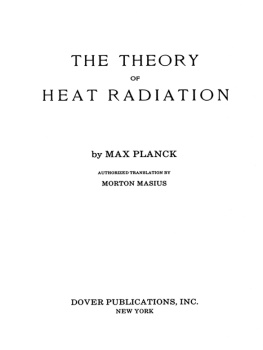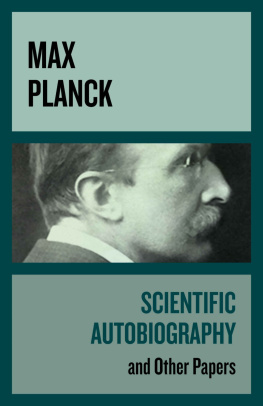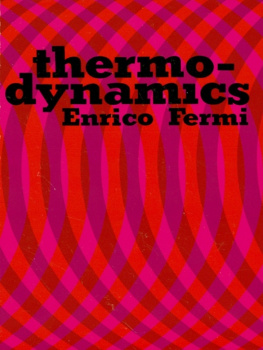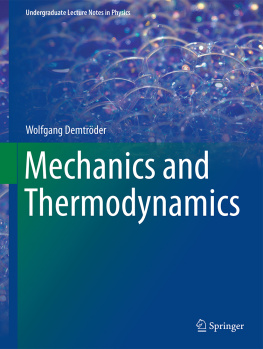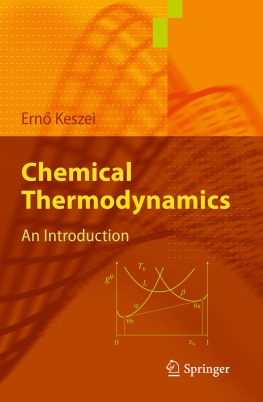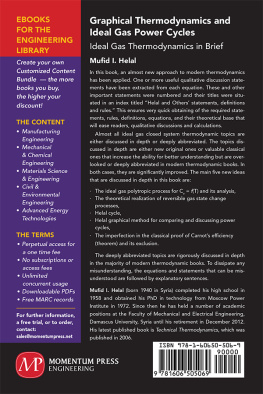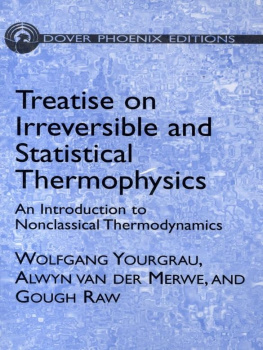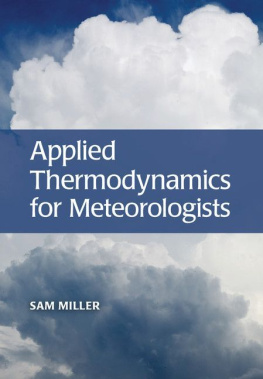TREATISE ON
THERMODYNAMICS
BY
DR. MAX PLANCK
PROFESSOR OF THEORETICAL PHYSICS IN THE UNIVERSITY OF BERLIN
TRANSLATED WITH THE AUTHORS SANCTION
BY
ALEXANDER OGG, M.A., B.Sc, P H .D., F.I NST .P.
PROFESSOR OF PHYSICS, UNIVERSITY OF CAPETOWN, SOUTH AFRICA
THIRD EDITION
TRANSLATED FROM THE SEVENTH GERMAN EDITION
DOVER PUBLICATIONS, INC.
NEW YORK
Copyright 1969 by Dover Publications, Inc.
All rights reserved under Pan American and
International Copyright Conventions.
This Dover edition, first published in 1969, is an unabridged and unaltered republication of the third revised edition originally published in 1917 by Mother Earth Publishing Association, New York. A new Introduction by Richard Drinnon has been added.
International Standard Book Number: 0-486-22484-8
Library of Congress Catalog Card Number: 72-98540
Manufactured in the United States by Courier Corporation
66371X07
www.doverpublications.com
PREFACE TO THE SIXTH AND THE
SEVENTH EDITIONS.
A MONG the additions to the new edition, I may mention the theory of the lowering of the freezing point of strong electrolytes, which has been developed by J. C. Gosch of Calcutta. This theory ( ) appears at last to clear up the puzzling deviations from Ostwalds dilution law. Debyes equation of state for solid bodies has also been added. This contains the explanation of the variation of the specific heat with temperature as well as Griineisens law for the thermal coefficient of expansion.
THE AUTHOR.
B ERLIN , G RXJNEWALD ,
February, 1921, and July, 1922.

TRANSLATORS NOTE.
T HE Second English edition of Prof. Plancks book was a reprint of the first, but in this edition pains have been taken to adhere as closely as possible to the seventh German edition, with the exception of a few symbols, which have been retained as in the first English edition.
It has been a great pleasure to work up this edition containing all the additions and corrections, which Prof. Planck has found necessary. The value of the book has been greatly enhanced.
A. OGG.
U NIVERSITY OF C APE T OWN ,
January, 1926.
FROM THE PREFACE TO THE
FIRST EDITION.
T HE oft-repeated requests either to publish my collected papers on Thermodynamics, or to work them up into a comprehensive treatise, first suggested the writing of this book. Although the first plan would have been the simpler, especially as I found no occasion to make any important changes in the line of thought of my original papers, yet I decided to rewrite the whole subject-matter, with the intention of giving at greater length, and with more detail, certain general considerations and demonstrations too concisely expressed in these papers. My chief reason, however, was that an opportunity was thus offered of presenting the entire field of Thermodynamics from a uniform point of view. This, to be sure, deprives the work of the character of an original contribution to science, and stamps it rather as an introductory text-book on Thermodynamics for students who have taken elementary courses in Physics and Chemistry, and are familiar with the elements of the Differential and Integral Calculus.

The numerical values in the examples, which have been worked as applications of the theory, have, almost all of them, been taken from the original papers; only a few, that have been determined by frequent measurement, have been taken from the tables in Kohlrauschs Leitfaden der prak-tischen Physik. It should be emphasized, however, that the numbers used, notwithstanding the care taken, have not undergone the same amount of critical sifting as tlie more general propositions and deductions.

Three distinct methods of investigation may be clearly recognized in the previous development of Thermodynamics. The first penetrates deepest into the nature of the processes considered, and, were it possible to carry it out exactly, would be characterized as the most perfect. Heat, according to it, is due to the definite motions of the chemical molecules and atoms considered as distinct masses, which in the case of gases possess comparatively simple properties, but in the case of solids and liquids can be only very roughly sketched. This kinetic theory, founded by Joule, Waterston, Kronig and Clausius, has been greatly extended mainly by Maxwell and Boltzmann. Obstacles, at present unsurmountable, however, seem to stand in the way of its further progress. These are due not only to the highly complicated mathematical treatment, but principally to essential difficulties, not to be discussed here, in the mechanical interpretation of the fundamental principles of Thermodynamics.
Such difficulties are avoided by the second method, developed by Helmholtz. It confines itself to the most important hypothesis of the mechanical theory of heat, that heat is due to motion, but refuses on principle to specialize as to the character of this motion. This is a safer point of view than the first, and philosophically quite as satisfactory as the mechanical interpretation of nature in general, but it does not as yet offer a foundation of sufficient breadth upon which to build a detailed theory. Starting from this point of view, all that can be obtained is the verification of some general laws which have already been deduced in other ways direct from experience.
A third treatment of Thermodynamics has hitherto proved the most fruitful. This method is distinct from the other two, in that it does not advance the mechanical theory of heat, but, keeping aloof from definite assumptions as to its nature, starts direct from a few very general empirical facts, mainly the two fundamental principles of Thermodynamics, From these, by pure logical reasoning, a large number of new physical and chemical laws are deduced, which are capable of extensive application, and have hitherto stood the test without exception.
This last, more inductive, treatment, which is used exclusively in this book, corresponds best to the present state of the science. It cannot be considered as final, however, but may have in time to yield to a mechanical, or perhaps an electro-magnetic theory. Although it may be of advantage for a time to consider the activities of natureHeat, Motion, Electricity, etc.as different in quality, and to suppress the question as to their common nature, still our aspiration after a uniform theory of nature, on a mechanical basis or otherwise, which has derived such powerful encouragement from the discovery of the principle of the conservation of energy, can never be permanently repressed. Even at the present day, a recession from the assumption that all physical phenomena are of a common nature would be tantamount to renouncing the comprehension of a number of recognized laws of interaction between different spheres of natural phenomena. Of course, even then, the results we have deduced from the two laws of Thermodynamics would not be invalidated, but these two laws would not be introduced as independent, but would be deduced from other more general propositions. At present, however, no probable limit can be set to the time which it will take to reach this goal.
B ERLIN ,
April

